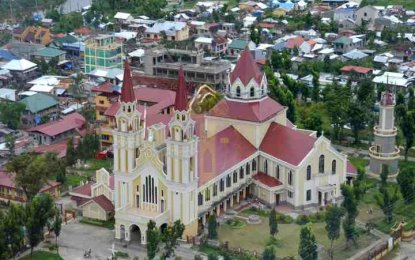
The Metropolitan Cathedral of Our Lord’s Transfiguration in Palo, Leyte is the venue of Passion Play, a tradition that has been running since 1974. (Photo courtesy of the Archdiocese of Palo)
PALO, Leyte -- About 50,000 devotees from different parts of Eastern Visayas will join the Holy Week observance in this town as part of the Roman Catholic tradition that has been kept alive for more than four decades.
Fr. Gilbert Urbina, liturgist of Palo Archdiocese, said the procession has been drawing a lot of pilgrims every year to witness the re-enactment of Jesus Christ’s suffering.
The re-enactment starts at noon of Good Friday and ends at 3 p.m. when Christ is crucified. All penitentes are played by men. They join the play on the Palo Cathedral grounds as a form of offering to the Lord.
“They are different groups of brotherhood with the aim to express their personal devotion to the Lord,” Urbina told reporters on Tuesday.
These men stay on until Black Saturday with some of them guarding the “body” of Christ in Palo Cathedral until Easter Sunday.
The person playing the role of Jesus will not be nailed to the cross during the play. Up for display, instead is a life-size image of Christ on the cross.
Palo native Brian Pacheco will act as Christ, a role he has been playing during “Pamalandong” (local term for meditation) since 2004, according to stage director Mabel Moron-Sevilla.
Sevilla, a retired college professor, said the main casts are now ready for re-enactment on Good Friday. The stage director is the daughter of former Palo Mayor Salvador Moron, founder of “Pamalandong.”
About 300 cast members of the “Pamalandong” theater group will join the re-enactment of Christ’s sacrifice using the original script written by the late priest from Carigara town, Msgr. Ben Lloren Sabillo.
The re-enactment is followed by the “Siete Palabras” where priests, acting as speaker, interpret the Last Seven Words of Jesus.
Before the re-enactment, there will be a Mass at the cathedral in the morning, followed by the Station of the Cross. Confession is then offered prior to the play.
The day’s activity will be capped by a procession dubbed as “Santo Entierro”, where the “body” of Jesus Christ is paraded around the town’s main streets.
Those who will not join the procession have the option to climb the Guinhangdan Hill as part of their penance.
The old cross atop the Guinhangdan Hill, which was built in the early 1960s, is one of the most concrete manifestation of the Catholic zeal in the town after the Jesuits arrived to bring Christianity to its inhabitants way back in 1596 and after the town survived the ravaged of World War II in 1940s.
Palo town is home to the offices of the ecclesiastical government of the Roman Catholic’s Archdiocese of Palo; the archbishop's residence; as well as the secondary, tertiary and theology seminaries of the archdiocese.
The diocese has 1.2 million Roman Catholic residents, 63 parishes, 1 chaplaincy and 13 mission stations, divided into two districts - the Eastern District for Waray-speaking people and the Western District for Cebuano-speaking resident. (PNA)
